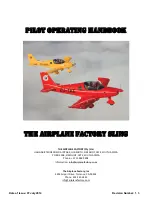
Sinus 912 LSA Glider 550 MTOW
www.pipistrel.eu
REV. 3
Training/Familiarization Supplement
This chapter has been written to assist owners/pilots/instructors of Sinus 912 LSA on their quest to learn
how to safely and efficiently fly this aircraft in addition to the information already assembled in the rest
of this POH. This section will cover most operations the aircraft offers in an order established in section
Normal procedures and recommended speeds. Please consider what follows as an add-on to that chap-
ter.
Engine start-up
First and foremost
make sure you have sufficient fuel quantity on board
for the desired length of
flight. If you are not completely confident there is enough, step out of the aircraft and add more fuel
into the tanks. There is an old aviators’ saying:
“The only time you have too much fuel is when you are on
fire.”
When engaging the engine starter, wheel brakes MUST be engaged.
To keep your propeller in
perfect condition, avoid starting up on areas where there are small stones on the ground. Those little
stones can easily be picked up by the propellers causing damage to the blades.
Warming up must be conducted below 2500 RPM.
When reaching safe operational engine tem-
peratures, verify maximum engine ground RPM.
Hold the stick back completely and slowly(!) add
throttle to full power, then verify RPM.
Taxi
Taxiing with the Sinus 912 LSA is rather simple considering the steerable nose wheel.
For sharper
turns
on the ground you can also
use wheel brakes
to assist yourself. It is recommended you
taxi
slow
, up to 10 km/s
(5 kts)
, while holding the stick back fully to ease the pressure of the nose wheel.
During taxiing monitor engine temperatures.
Due to low airflow around the radiators the CHT and
Oil temperature will rise during long taxi periods. If you are holding position, do not leave throttle at
idle. It is better you have some 2500 RPM as this will provide some airflow from the propeller to the
radiators and the temperatures will not rise so quickly.
Should you see engine temperatures exceed
safe operational values, shut off the engine, point the aircraft’s nose into the wind and wait for
the temperatures to reduce.
Take off and initial climb
Having checked and set all engine and aircraft parameters, you should be ready for take off by now.
Reverify both fuel valves be open and the airbrakes retracted and locked (handle full up). Trim
lever should be in the middle.
Start the take-off roll gradually.
Keep adding throttle slowly and smoothly full power. There are two
reasons for this. First, you change flight stage from zero movement to acceleration slowly; this pro-
vides you with time to react to conditions. Second, especially if taking-off from a gravel runway, this
method of adding full throttle will prevent the little stones on the runway from damaging the pro-
peller. Extremely short runways are an exception. There you should line up the aircraft, set flaps to 2
nd
stage, step on the brakes, apply full power and release the brakes.
As you start to move, pull the stick 1/3 of elevator’s deflection backwards
to ease the pressure on
the nose wheel and lift it off the runway slightly.
Do not use full back deflection as this will cause
the aircraft’s tail to touch the ground.
Appendix
9-8
















































